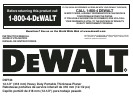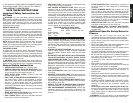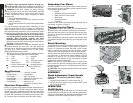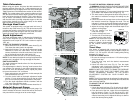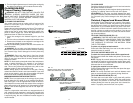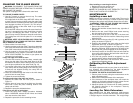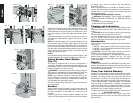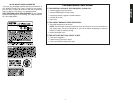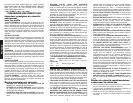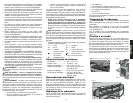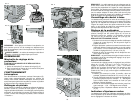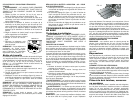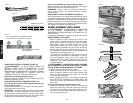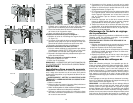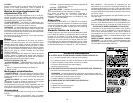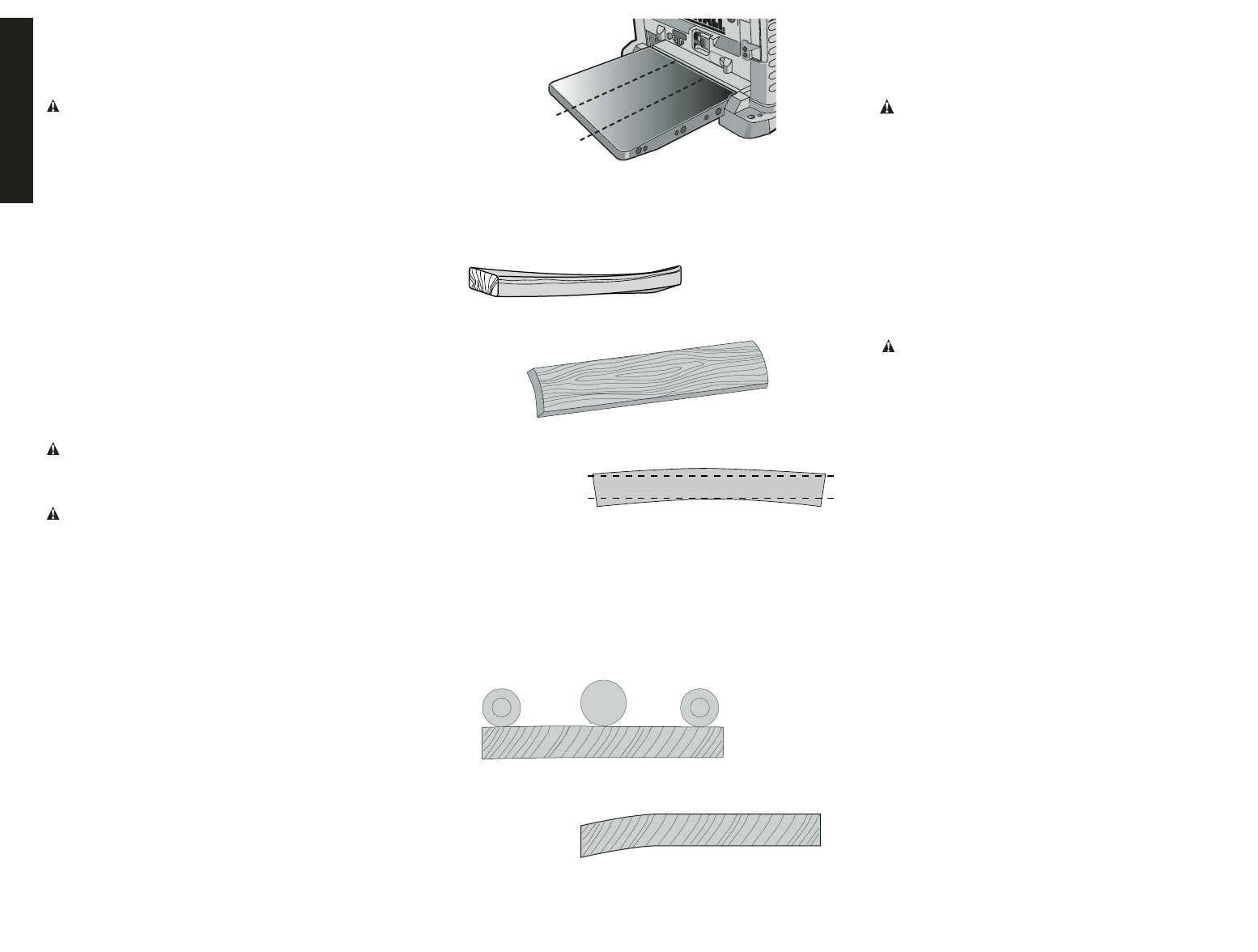
English
4
3. Turn the depth adjustment crank, lowering the carriage by
the desired increments, until it contacts the turret stop.
PLANING BASICS
Proper Planing Technique
WARNING: DO NOT TURN THE UNIT ON WITH THE
MATERIAL ALREADY INSERTED UNDER THE CAR-
RIAGE. WAIT UNTIL THE ROLLERS AND CUTTER HEAD
ARE UP TO FULL SPEED BEFORE FEEDING YOUR
MATERIAL INTO THE MACHINE.
TO PLANE YOUR MATERIAL
Your planer works best on lumber with at least one flat
surface. If both sides of your workpiece are rough, use a
jointer to level one face.
Support the workpiece adequately at all times. The maximum
depth of cut your planer can take in one pass is 1/8" (on
material less than 6" wide). Never attempt to modify your
planer to take a deeper cut. Follow the depth/width of cut
guidelines shown in Table Afor best results.
1. Lower the carriage to the desired height for your first
pass.
2. Turn the unit on and feed the material into the feed rollers.
3. Examine the finished cut and adjust the carriage to the
appropriate height for your next pass.
See the Troubleshooting Guide at the end of this section for
more information.
WARNING: Do not place your body between the work-
piece and a stationary structure while the material is feeding
out. Personal injury and/or damage to the work piece may
occur.
WARNING: Plane only wood that is free from foreign
objects, with no loose knots and as few tight knots as pos-
sible. Do not plane wood that is severely warped, twisted,
knotted or bowed.
NOTE: For best results, plane both sides of the workpiece to
reach a desired thickness. For example, if you need to
remove 1/8" from your workpiece, remove 1/16" from each
side. This not only allows the workpiece to dry with a even
moisture content, it also produces finer cuts.
NOTE: Always plane in the direction of the grain. Planing
material less than 3/4" wide is not recommended. If you must
plane narrow material, group the pieces together and plane
them as one wide workpiece whenever possible.
MINIMUM/MAXIMUM WIDTH/HEIGHT/DEPTH
NOTE: There is a certain area on the carriage of your planer
that will allow the 1/8" depth of cut on material less than 6"
wide. See Figure 12 for an approximate location of this area.
Your material must move under this section of the carriage or
planer will not take a 1/8" depth of cut. If the material is wider
than 6", it will not fit through this area with an 1/8" depth cut.
Snipe
Snipe is a depression made when an unsupported end of
your material bends downward, causing the opposite end
to lift up into the cutter head. If you are planing material that
is especially long, the use of additional material support is
recommended.
TO AVOID SNIPE
Feed the workpiece into the planer so it is level and remains
flat against the base at all times.
Keep long workpieces level throughout planing operation by
receiving or “catching” them from the rear of the planer.
WARNING: Do not place your body between the work-
piece and a stationary structure while the matertial is feeding
out. Personal injury and/or damage to the work piece may
occur.
Twisted, Cupped and Bowed Wood
If both sides of your material are very rough or if the materi-
al is cupped, bowed or twisted, the planer may not produce
the desired result. Ideally, you should have at least one level
face/surface on your material before you plane. Your thick-
ness planer will work best with material that has been run
through a jointer to produce one flat surface. If you do not
have at least one flat surface or a jointer, see the the follow-
ing recommendations:
TO PLANE TWISTED WOOD (FIG. 13)
WARNING: TWISTED WOOD MAY JAM YOUR THICK-
NESS PLANER. IF A JAM OCCURS, TURN THE POWER
OFF, DISCONNECT THE POWER SUPPLY AND RAISE
THE CARRIAGE TO RELEASE THE MATERIAL FROM
THE CUTTER HEAD.
To plane only slightly twisted material:
Plane both sides alternating from one to the other until the
desired thickness is reached.
TO PLANE CUPPED WOOD (FIG. 14)
To obtain the best possible results with cupped wood:
Rip the material down the middle and plane it as two sepa-
rate pieces.
NOTE: Ripping the material reduces the severity of the cup
and allows the machine to deliver better results. More mate-
rial will be removed on cupped wood to achieve the desired
thickness than on a normal board.
If ripping the material is not an option:
Plane one side of the material until flat, then plane the oppo-
site side until flat (Fig. 15).
NOTE: Do not flip the board back and forth between each
pass as recommended by the general planing directions.
TO PLANE BOWED WOOD (FIG. 16)
The feed rollers and cutter head in your planer will push the
bow out of the material as it feeds. When the material exits
the planer, the pressure of the rollers and cutter head will
release allowing the wood to spring back into a bowed for-
mation. To properly remove the bow, use a jointer.
R
FIG. 12
FIG. 13
TOP FLAT
BOTTOM FLAT
FIG. 14
FIG. 15
FIG. 16
BOWED WOOD WILL BE FLATTENED BY
FEED ROLLERS AND CUTTER HEAD…
…BUT BOW WILL RETURN AFTER
WOOD IS PLANED



